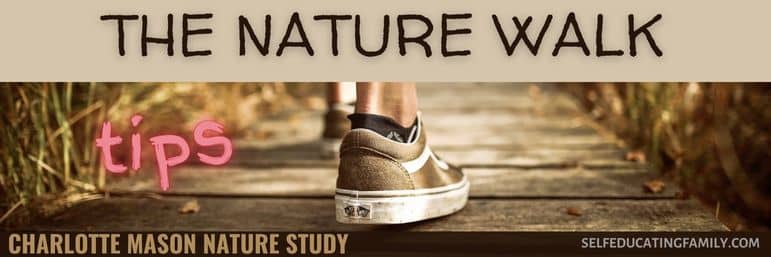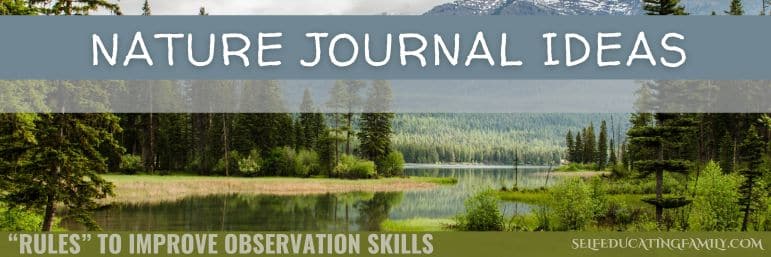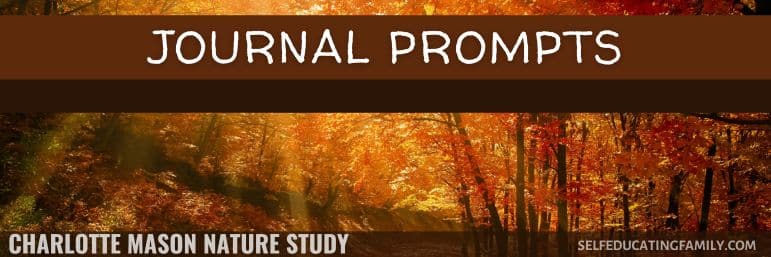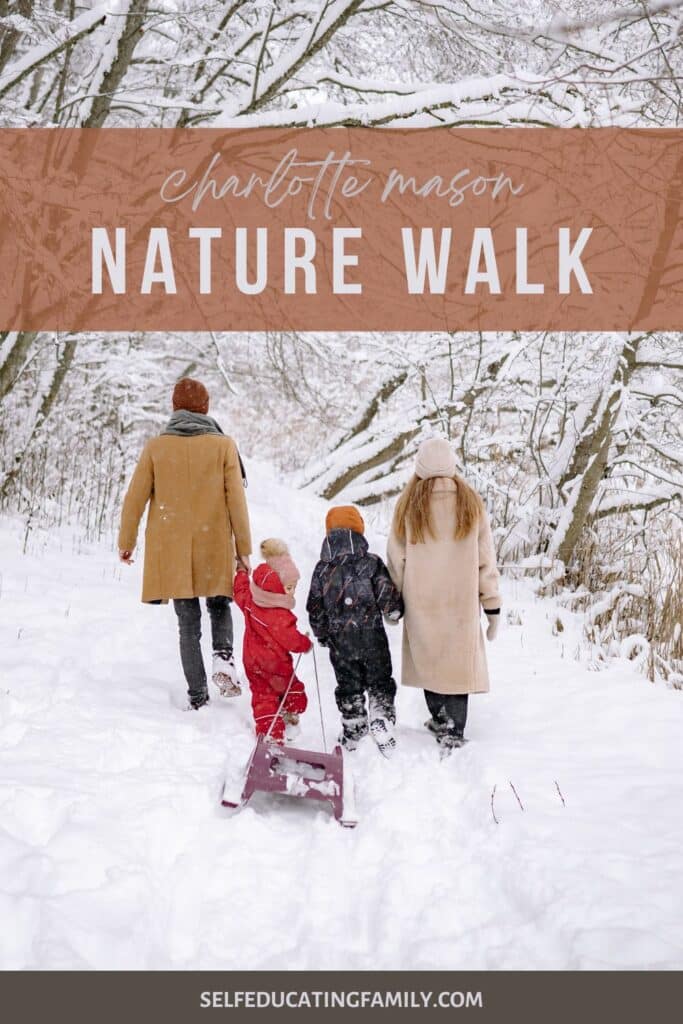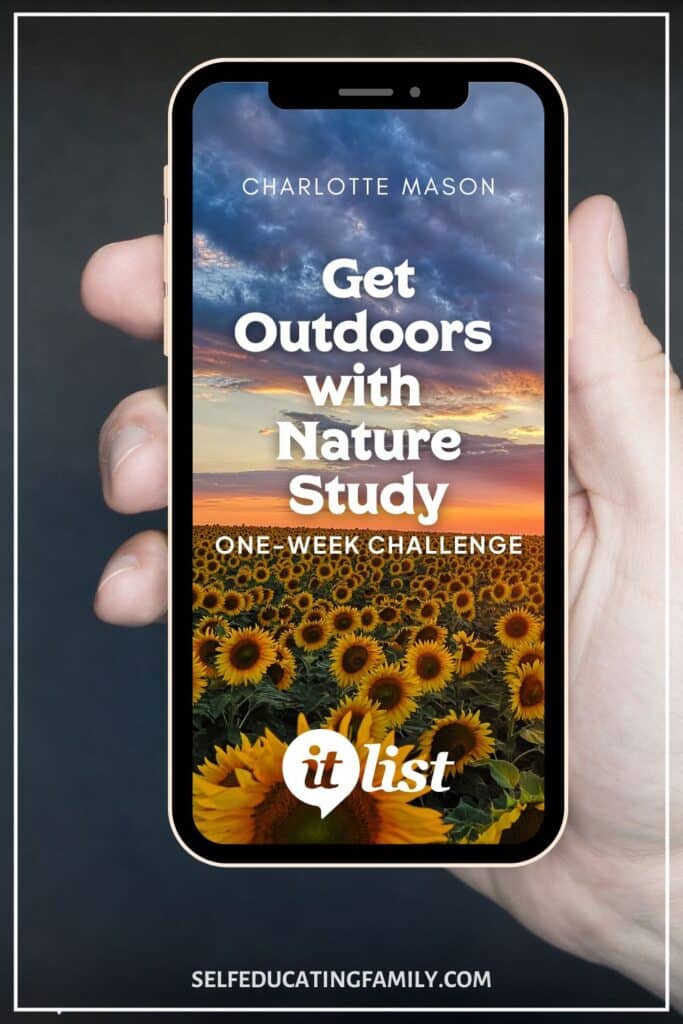Notes on Nature Study
What’s inside: Pointers on how to DO nature study using the nature walk. (The other part of nature study is Documenting which we’ll look at separately). Getting your kids out in nature is vital to their well being. Homeschoolers can take advantage of this natural way to learn in their homeschool day.
Why Nature Studies?
According to Charlotte Mason (CM), nature study is essential for a complete education.
Does that statement seem out-of-date for today’s technologically driven society?

Well, in a world where we run from one activity to the next, it might behoove us all to “stop and smell the roses.”
I’ve read a lot about nature study and I prize the time I can spend out-of-doors soaking in nature. So I admit, I’m biased.
However, from what I’ve read in CM methods, nature study has more to it than just “liking being outside”.
Reasons for Nature Study
According to CM, Nature Study:
- Works off of the natural interest that kids have about nature.
- Lays the foundation for formal science.
- Increases the love of investigation.
- Helps grow your kids’ ability to understand the unknown.
- Gives your kids a sense of stewardship towards the earth.
Two Parts to Nature Study
I read an interesting article on Squidoo* a long time ago about Nature Study that broke it into two parts: Doing & Documenting.
Note: *Squidoo was an ancient online platform that was swallowed up by Hubpages. I have since found the original article by Jimmie Quick and the link is included in the resources at the bottom of this post.
DOING & DOCUMENTING
The Doing part of Nature study can be accomplished easily via the Nature Walk. The documenting can be done by keeping a nature journal.
Try to keep it simple as you get started and try not to over-complicate the subject too much.
DOING
Doing nature study can be as simple as taking a walk outside.
Simple, yes, but what is necessary is consistency.
“But to do Nature Study well, you will need to make a consistent effort to make time for it. According to Charlotte Mason, every child has an innate interest in nature, but it is the parents’ responsibility to encourage it. Otherwise it will be lost as the child matures into adulthood.”
-Jimmie Quick
CM suggested time outdoors everyday, and during pleasant weather, from April to October, her recommendation is even four to six hours each day spent in the fresh air!
But for many CM homeschoolers, a weekly nature walk fits their schedule well. Whatever frequency you choose, remember Miss Mason’s words, “Never be within doors when you can rightly be without.”
How and When will you schedule Nature Study?
Choose from these ideas for scheduling time for nature study (in descending time order):
- Go outside for 4-6 hours a day (great for preschoolers or summertime)
- Add “Nature Study” as a subject for every afternoon.
- Eat lunch or breakfast “al fresco” weather permitting.
- Put “Nature Study” into your loop schedule.
- Plan on a nature walk for 15-20 minutes a day or do some nature observations while walking the dog.
- Opt for a longer nature walk or hike for 1-2 hours once a week – you can organize a group for accountability.
- Get together once a month with a local group for a combination of nature study and socializing.
- Jumpstart a season of nature study by having an “intensive” – like a week-long “camp” or take a nature journal with you on your next vacation.
These are just a few ideas to get you going. Plan on doing something, regularly. Daily, twice-weekly, weekly, biweekly, monthly, or seasonally. Start now. Then keep going.
To keep it fresh
When you plan your “nature study,” be sure to keep it fresh. Kids have a natural curiosity, but we adults can accidentally sabotage their interests. Give a lot of encouragement, with not so much instruction or correction. Nature study is more about the process of exploration & observation and less about the correct answers or way to do something.
Then again, you need to find the balance of “just enough” instruction so that the child develops skills and not frustration. We found keeping drawing lessons separately helped.
Reminders from CM
Tips From Home Education:
- Be out of doors quite a lot with no excuses. Whether city or suburb, weather the weather.
- Use “Sight-seeing”, a method of training kids to be observant. This does not have too much intervention from mom.
- Use “picture painting” sparingly – where mental images are studied, remembered, and recalled. This is fatiguing, so don’t do it too often, but it’s fun for a break now and then.
Brilliant Suggestions and “games” for the Nature walk from CM:
- Know Your Directions
- Where is E, W, N, and S?
- Where is the sun?
- About what time of day is it? (using the sun)
- Which way are we traveling?
- Compass drills
- Distance games
- How long does it take to walk 200 yards?
- A quarter mile?
- How many steps do you take in 10 yards?
- What about 100 yards (a football field)?
- How do your steps change if you run?
- How long does it take to walk 200 yards?
- Combining Distance & Directions
- Draw plans of familiar areas, like:
- Your garden
- Your yard
- Your block
- Your neighborhood
- Draw plans of familiar areas, like:
- The third dimension:
- Climbing rocks
- How tall is that tree?
- Can you estimate a building’s height?
- How tall is a car? Or a street sign? Or a person on a bicycle?
Again, get new ideas to keep the creative juices flowing.
DOCUMENTING
Documenting is the second half of nature study. Remember, it’s not science if you don’t write it down!
CM on documenting
This is a long quote, but it gives the gist of how and when to use the nature journal:
“Nature Diaries.––As soon as he is able to keep it himself, a nature-diary is a source of delight to a child. Every day’s walk gives him something to enter: three squirrels in a larch tree, a jay flying across such a field, a caterpillar climbing up a nettle, a snail eating a cabbage leaf, a spider dropping suddenly to the ground, where he found ground ivy, how it was growing and what plants were growing with it, how bindweed or ivy manages to climb.
Innumerable matters to record occur to the intelligent child. While he is quite young (five or six), he should begin to illustrate his notes freely with brush drawings; he should have a little help at first in mixing colours, in the way of principles, not directions. He should not be told to use now this and now that, but, ‘we get purple by mixing so and so,’ and then he should be left to himself to get the right tint. As for drawing, instruction has no doubt its time and place; but his nature diary should be left to his own initiative. A child of six will produce a dandelion, poppy, daisy, iris, with its leaves, impelled by the desire to represent what he sees, with surprising vigour and correctness.
—Charlotte Mason Home Education, Vol 1 pg 55-56
If your child is uncomfortable with a blank book at first, begin with some simple journal pages or notebooking pages with prompts or with a simple formula to use for each outing or page that records basic facts:
- Name, date & time
- Place
- Weather, moon cycle, wind & clouds
- Then record something that you see that day in that place. You can use words, lists, pictures, or diagrams. There are no set rules about this.
Clare Walker Leslie has fantastic recommendations in her book Keeping a Nature Journal. She has ideas to get you started and even more ideas as you keep practicing. This book is highly worthwhile for young and old naturalists, and it’s a wonderful accompaniment to Anna Botsford Comstock’s Nature Study Handbook.
Free Notebooking Pages
If you need some more sample pages, here are a few sources:
- Notebooking in Nature Studies | Notebooking Fairy
- Free nature notebook printables and resources | Amy’s Wandering
- Cycles of Nature Notebooking Pages | Jimmies Collage
Need more specifics?
Here’s a great idea from Allison at Adding to the Beauty:
Besides showing you her schedule for 3 different ages (super useful!), she has set up a “Nature Table” in her home where supplies and ideas sit waiting for nature observation and journaling.
Recap
Do, and then document.
Go out in nature – on a walk, for instance, to observe and chronicle your observations. Keep a journal – don’t worry if it’s not perfect. The more you record your observations, the better you will get.
If you need more inspiration, check out what these famous people thought about getting out in nature.
Just start, and then keep going.
Keep on Learning
Related Articles
Other Resources
Nature Journaling:
Nature Study Blogs:
- Handbook of Nature Study – based on Anna Comstock’s book
- Nature Study | Ambleside Online
- Notebooking Nature | Notebooking Fairy
- The Minimalist Guide to Nature Journals | The Homeschool Scientist
Books:
- Keeping a Nature Journal by Clare Walker Leslie
- Handbook of Nature Study by Anna Botsford ComstockCharlotte Mason recommended this classic volume as a nature study resource. Because this book is in the public domain, it is also available as a free online text.
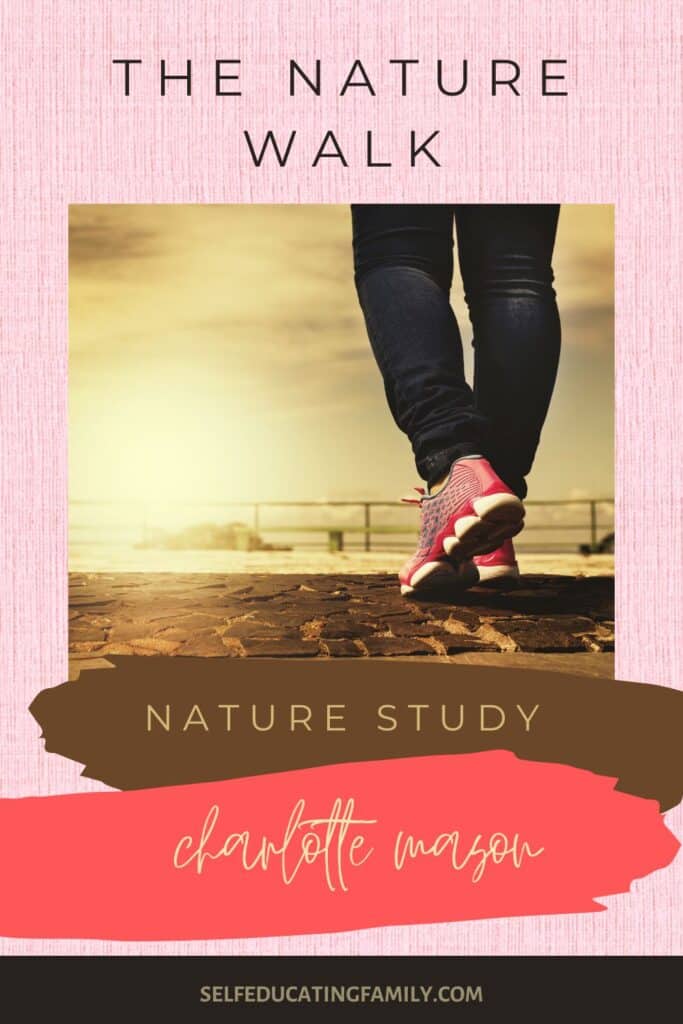
If you would like more detail on working with a nature journal, then try my One-Week Challenge: Get Outdoors with Nature Study.
